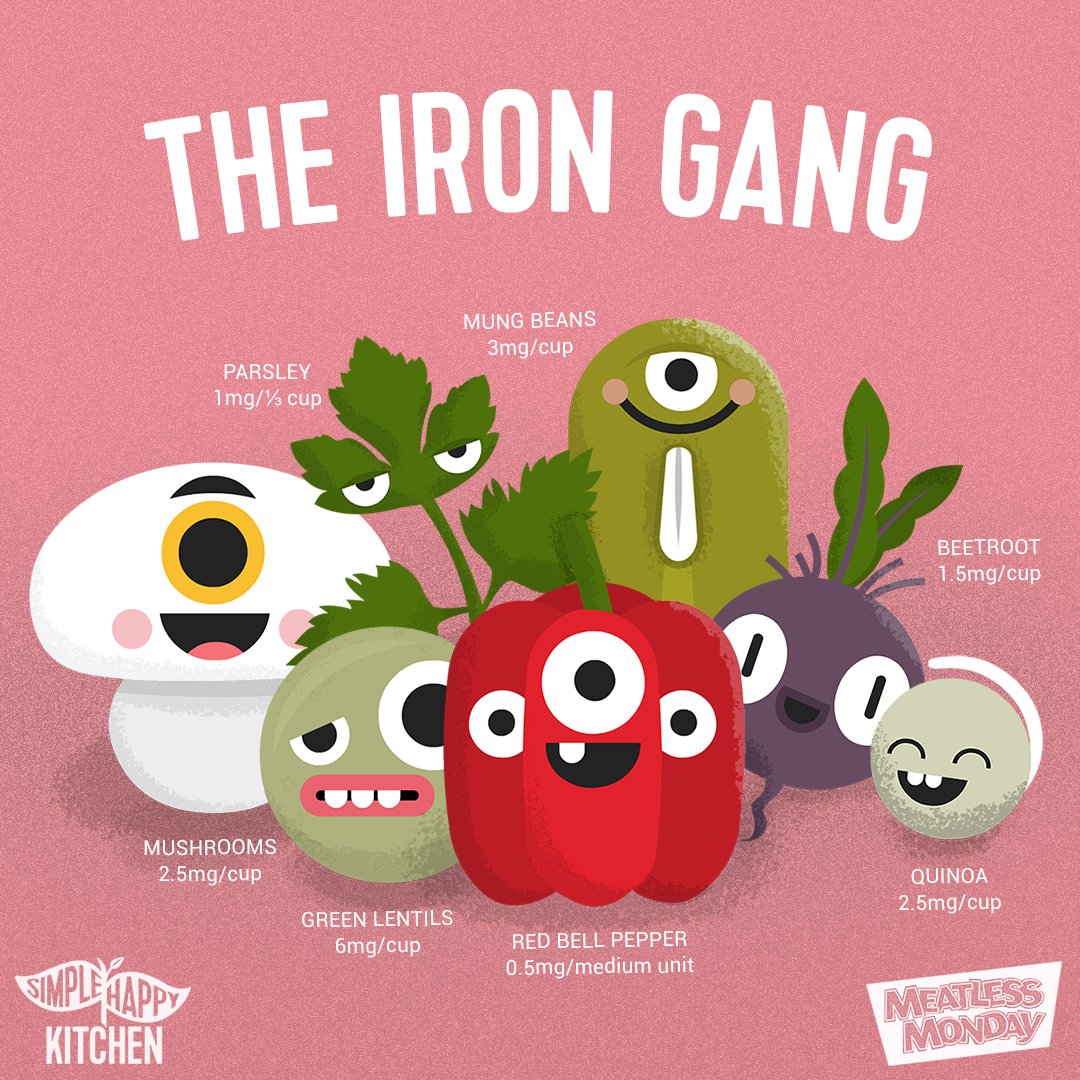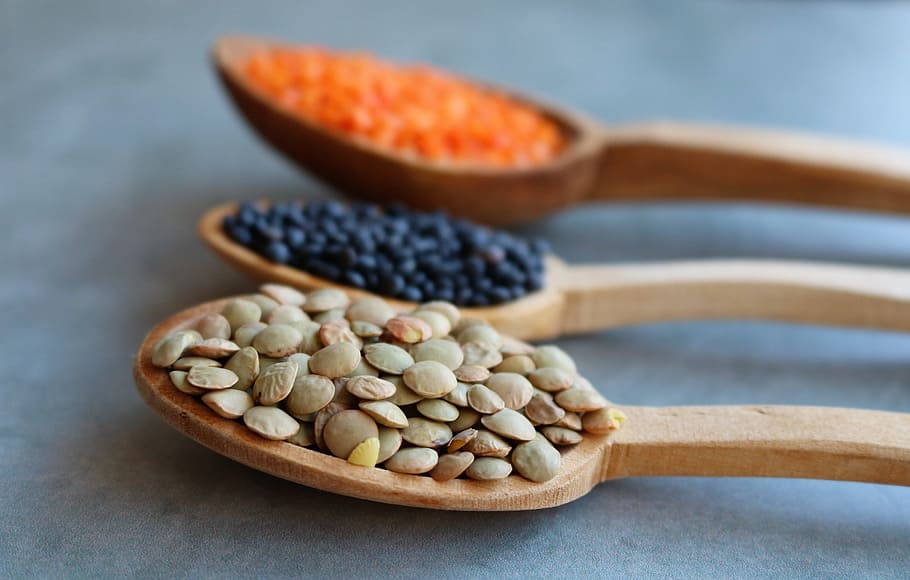Getting enough iron on a plant-based diet is a hot topic for both those considering and those following a vegan diet. Sadly, some people believe they can’t get enough iron on a plant-based diet to stay healthy. A couple of friends have mentioned they ditched their vegan diets because they felt they needed to eat meat to ensure their iron stores were high enough. Ugh. Don’t despair, you do not need to eat animals to ingest adequate iron!
Ironically, non-heme iron, which is the iron from plant sources, is the most beneficial for the body and is protective against certain diseases. Heme-iron, which comes from meat, is easier for the body to absorb, but brings with it risks. Read on to find out more!
What is Iron and Why is it Important?
Iron is an essential mineral. Iron helps transport oxygen throughout the body. It is an important component of hemoglobin, the substance in red blood cells that carries oxygen from your lungs throughout your body. If you don’t have enough iron, your body can’t make enough healthy oxygen carrying red blood cells. (1)
You can become fatigued if your body is not getting enough oxygen. This can affect your your brain function as well as your ability to fight off infections.
Iron also is essential for healthy hair, nails and skin. It is very important to have the proper amount in your diet. Too much or too little iron in your body can cause issues.
How Much Iron Do You Need?
Your iron needs vary based on your age and gender. Click here for more information on recommended daily allowances of iron. As a general rule, women between the ages of 19-50 should get 18 mg of iron each day. Men, on the other hand, need only 8 mg.
Adolescents and pregnant mothers need more than men and postmenopausal women. Women tend to be more iron deficient as they regularly lose blood with their menstrual cycle, whereas men have no way to release iron from their system. This fact can sometimes cause men to accumulate too much iron. Both situations can cause problems.
How do you know if you are iron deficient?
Some symptoms of a possible iron deficiency are:
- appearing pale
- feeling fatigued
- having cold hands and feet
- having brittle and spoon shaped nails
- hair loss
- sores at the corner of the mouth
- feeling short of breath
- craving strange substances such as dirt or clay
- restless legs syndrome (an urge to move your legs while in bed)
A simple blood test from your doctor can diagnose different stages of iron deficiency. It is important not to take an iron supplement unless prescribed by a doctor. More iron is not necessarily better. If you are taking a supplement, keep it out of reach of children as it can be fatal. (2)
What is the difference between Heme and Non-Heme iron?
Heme iron is found in poultry, meat and seafood.
Nonheme iron, comes from plants such as legumes (lentils and beans), whole grain breads and dried fruits, green leafy vegetables, as well as nuts and seeds and fortified breakfast cereals.
Our bodies can absorb both types of iron but heme iron is absorbed more easily. That does not make it the best option however…
Heme iron
Heme iron comes from the blood and muscles of animals. According to Dr. Greger, if you look at iron intake solely from meat, it is associated with a significantly higher risk for heart disease. That is because heme iron can act as a pro-oxidant, which contributes to the development of atherosclerosis by oxidizing cholesterol with free-radicals. The intake of meat iron, but not plant iron, is associated with an increase in heart disease, cancer, stroke and Type 2 diabetes.
Decreasing sources of heme-iron in the diet is a potential strategy for decreasing the risk of metabolic syndromes and decreasing the risk of heart disease.
For more information on this topic, watch the short video below.
Non-heme iron
Although it is commonly thought that vegans and vegetarians would be more prone to iron deficiency, they are actually no more likely to suffer from it than meat eaters. This may be because plant-based eaters tend to have diets higher in fiber and vitamins and minerals and may get a lot of iron in their diet. (3)
The Best Sources of Plant-based Iron
Instead of getting our iron from meat, organs, such as liver, (Yuck… I have never been able to figure out why people would eat an organ that strains the toxins and impurities out of blood…)
Plant Foods that are High in Iron
- lentils (very high in iron – one cup of cooked lentils contains 6.6 mg, which is 37% of the recommended daily amount
- sesame seeds (tahini- sesame paste is very high in iron)
- chickpeas
- peas
- soybeans
- navy beans
- kidney beans
- black beans
- pumpkin seeds – one ounce serving of pumpkin seeds contains 2.5 mg of iron, which is 14% of the recommended daily serving
- broccoli
- spinach and kale
- tofu
- quinoa
- Dark chocolate (Halleluiah!) – one ounce serving contains 3.4 mg of iron, which is 19% of the recommended daily serving
- sunflower seeds
- whole-grain cereals (especially fortified ones)
- Nuts (especially, cashews, almonds, brazil nuts)
- dried fruits (raisins, apricots, prunes)
Foods that hinder iron absorption
- coffee
- teas
- red wine
In order to absorb the most iron from the foods you eat, avoid drinking coffee, tea and red wine, (dang it), with or after eating iron rich foods. The problem comes from the tannins in these drinks. Tannins fall into a class of plant compounds called polyphenols. They are found in regular tea, herbal teas such as peppermint tea, red wine, coffee and some berries (such as cranberries). Although tannins have some health benefits, they can interfere with the absorption of iron in the body. Therefore they shouldn’t be consumed during or after eating foods rich in iron. (4)
In my younger years, when I could still sleep after, I used to often have a coffee with dessert. Now I realize that was hindering my body’s ability to absorb the iron in my meal. It is also counter productive to consume calcium rich foods or drinks with meals containing iron. This is because calcium can also interfere with iron absorption.
Foods that help with iron absorption
In order to absorb the most iron from the foods you eat, it is advisable to consume foods high in vitamin C along with your iron rich foods. For example, if you are having a kale salad, make sure that the dressing contains lemon juice, such as my addictive Kale Caesar Salad recipe. This recipe is very high in iron as it is filled with tahini and kale.
Or if you are enjoying an iron rich Beluga Lentil Chili, serve red pepper with Chickpea Hummus. You will get a double dose of iron with the lentils and the chickpeas, and the red pepper will provide the vitamin C required for absorption. Another great meal to make to increase your iron intake is my Mushroom Lentil Plant-loaf!
When you eat iron rich foods, pair them with foods high in beta carotene. This will increase your iron absorption. Foods high in beta carotene include: carrots, sweet potatoes, dark leafy greens, romaine lettuce, squash, cantaloupe, apricots and red and yellow peppers.
Other Helpful Ways to Increase your Iron Intake
Cast Iron Pans
Another thing that can help with getting more iron into your diet is the way in which you cook your food. Use a cast iron pan to cook your food in to get added iron. The iron from the pan leaches into your food.
“Lucky Fish”
There are also little iron fish you can buy called “Lucky Iron Fish” that you can place in your soup or cooking water to add iron! It is a great concept. Also, a portion of the proceeds sends the Lucky Iron Fish to malnourished communities in 3rd world countries. I bought one a couple of years ago, and I add it to my soups and stews and cooking water when I remember!
Free printables
A couple of years ago, I found the most adorable website called Simple Happy Kitchen. They have the cutest illustrated characters to represent foods that are high in calcium, protein, iron, etc. They also offer free downloadable and printable sheets. Click here for a free download. It was a Kickstarter to get the company going so I purchased their book and posters. These hang in my pantry to remind my family of the foods they should be getting a lot of. These are great, especially for kids, to explain plant-based eating. Check out their cartoon characters! Adorable right?!

I hope you found this informative and that this article encourages you to eat your plant-based iron rich foods. Fingers crossed that you now feel more confident that you can obtain all of the iron your body needs on a cruelty free diet!
Resources:
(1) WebMD Feature written by Stephanie Watson, Reviewed by Brunilda Nazario, MD on July 12, 2011, https://www.webmd.com/vitamins-and-supplements/features/iron-supplements#1
(2) Healthline.com – Medically reviewed by Katherine Marengo, LDN, RD, specialty in nutrition, on February 7, 2019 — Written by Annette McDermott https://www.healthline.com/health/best-diet-plan-for-anemia
(3) Michael Greger M.D. FACLM June 5th, 2015 Volume 25https://nutritionfacts.org/video/the-safety-of-heme-vs-non-heme-iron/
(4) https://www.mydr.com.au/nutrition-weight/iron-intake-for-vegetarians

